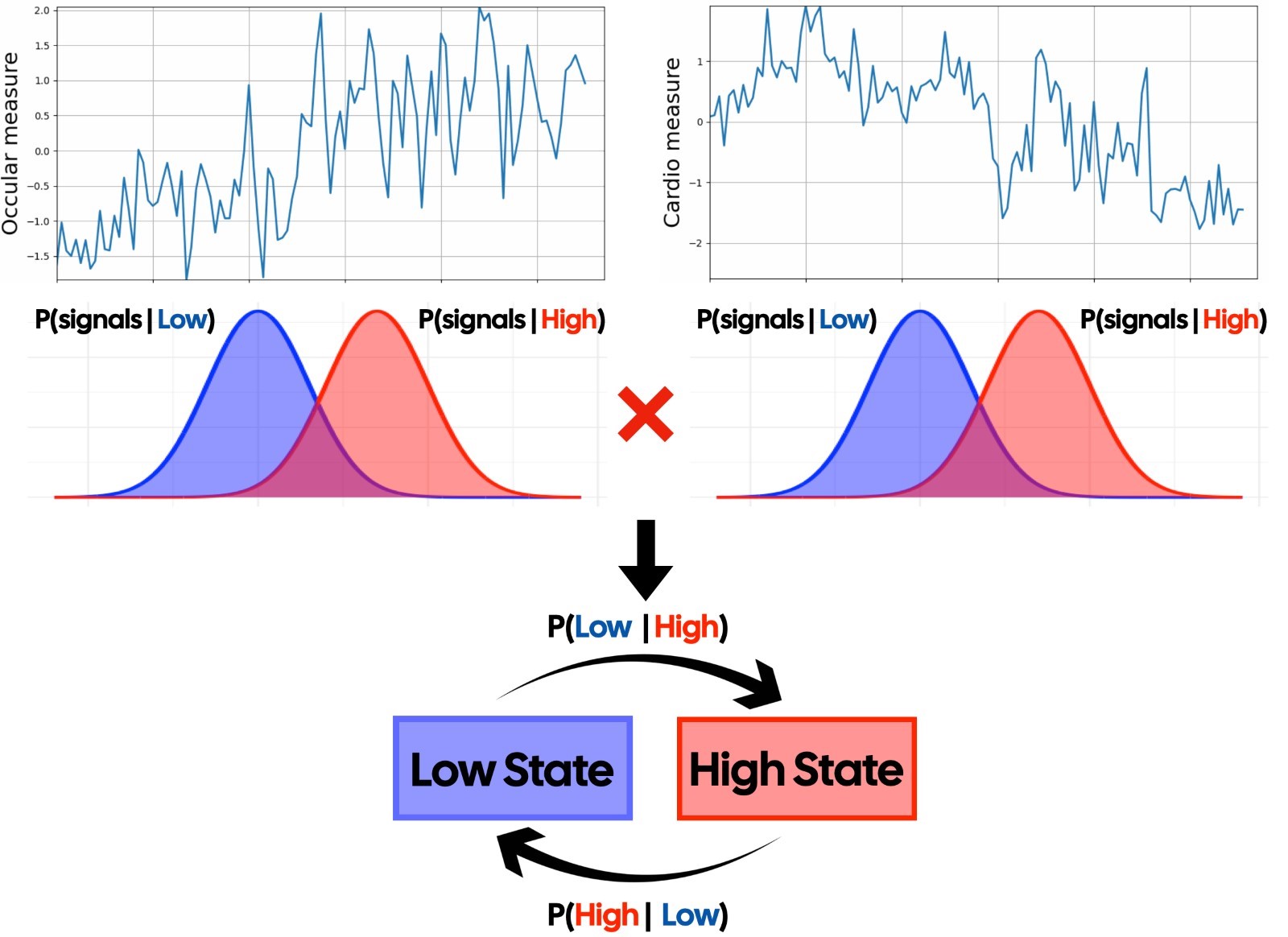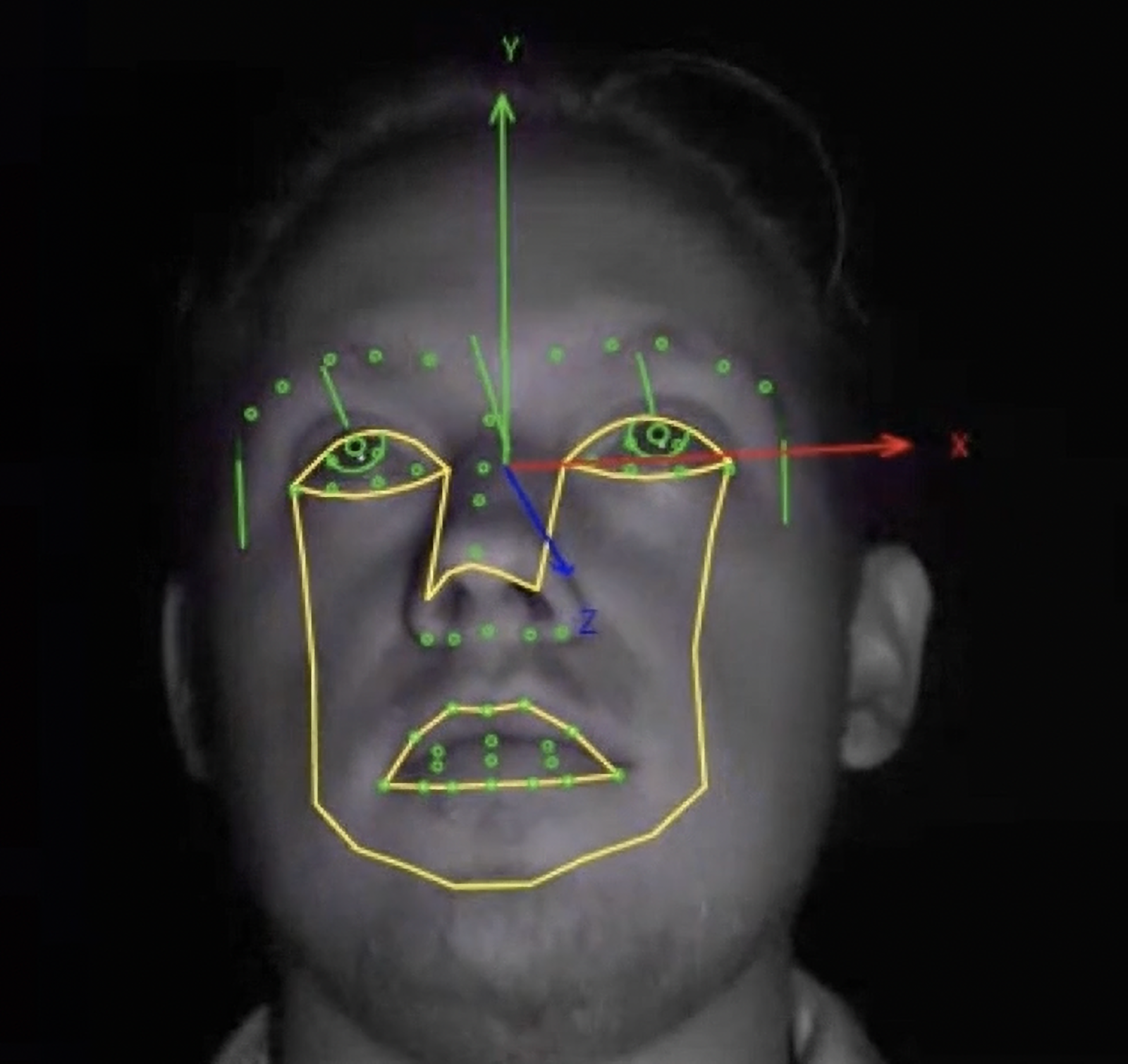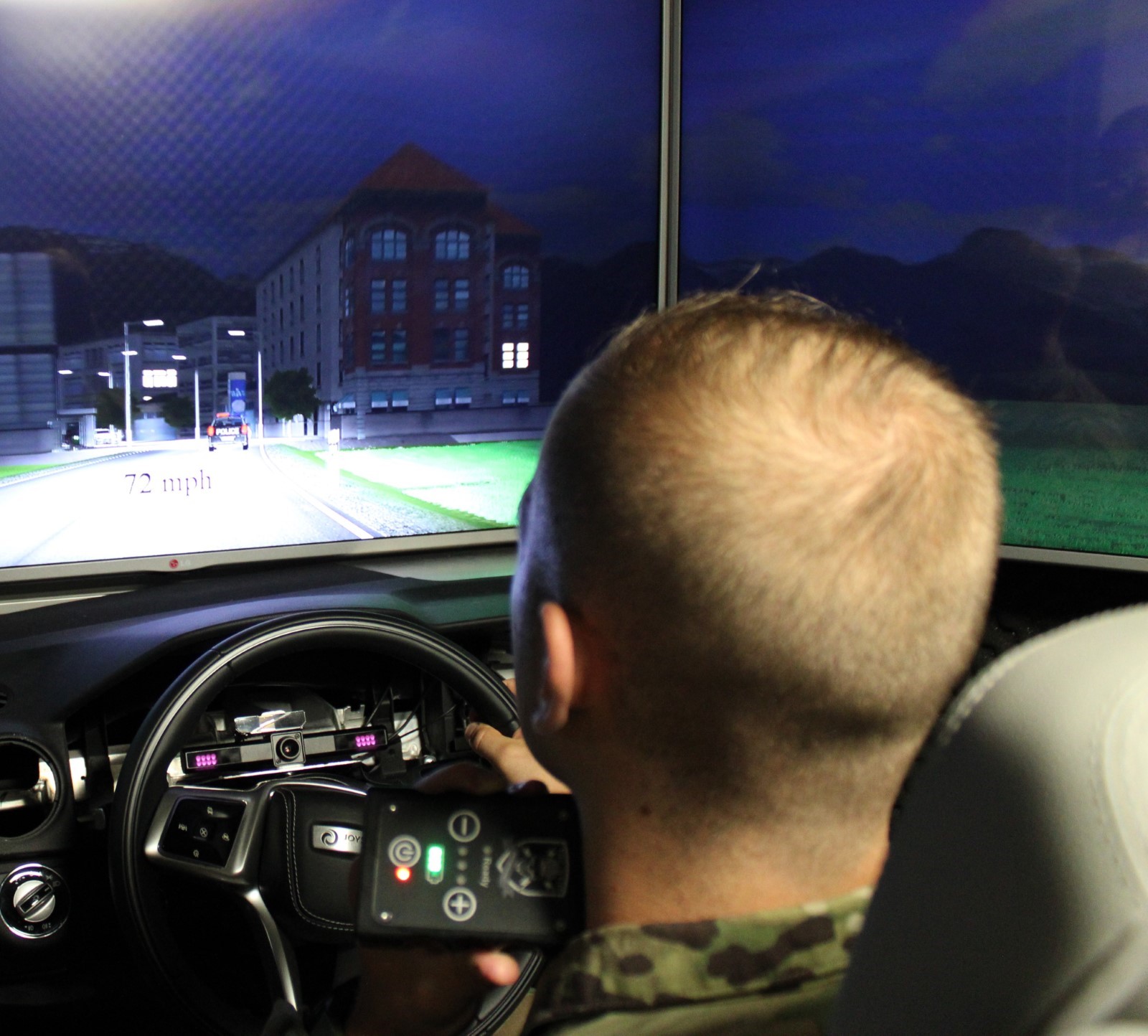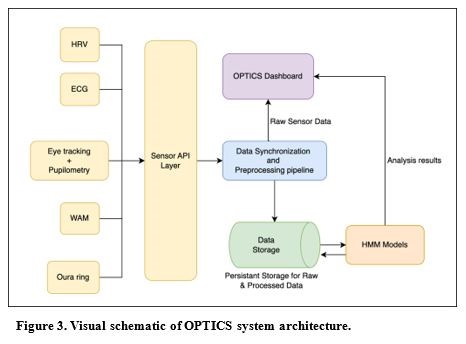The OPTICS (Ocular and Physio-Temporal Indicators of Cognitive States) project, piloted by Kairos Research, in collaboration with Wright State University, Sinclair Community College, The Dayton Entrepreneur Center, Air Force Research Laboratory (AFRL), and the Naval Aerospace Medical Research Unit in Dayton (NAMRU-D) and was funded by the Ohio Federal Research Network (OFRN), is tackling a highly critical challenge in high-stakes military operations, as well as other high-performance industries. This project is working towards effectively detecting and managing fatigue, stress, and cognitive load in real-time. With applications covering defense, healthcare, and workplace productivity, OPTICS is poised to redefine how we monitor cognitive states and optimize human performance.

The Consequences of Performative Gaps
Fatigue, stress, and cognitive overload are universal challenges faced by operators in high-pressure environments, from military drone pilots to healthcare professionals and truck drivers. We were able to sit down with Senior Research Scientist at Kairos Research, Tehran Davis, to better understand the importance of identifying sub optimal cognitive states early. In roles such as military drone operations or aviation, minor lapses in performance or attention due to fatigue can lead to catastrophic consequences and costly errors.
Cognitive state assessments have traditionally relied on subjective reports or performance measures. Subjective reports are intrusive, unreliable, and retrospective, while performance is a lagging indicator. OPTICS fills this gap by using real-time physiological signals, a method long studied in labs but now feasible in operational settings due to advances in technology and machine learning.
“Fatigue doesn’t manifest in a single form,” said Davis. “We’re looking at a range of different signals that, together, can give us a more complete picture of one’s cognitive state. By combining these indicators, we’re able to detect when performance starts to decline—often before the individual is aware of it themselves.”

The Power of Physiological Data
OPTICS uses advanced technology to track head and eye movements and measure physiological data, such as heart rate and breathing patterns, to provide reliable indicators of fatigue. Since fatigue, workload, and stress are closely linked, these signals can also reflect changes in cognitive workload and stress levels. Changes in pupil size, head movement, and eye movement patterns—such as fixation on a single point rather than exploring the surrounding environment—are key markers of fatigue. Heart rate and skin conductance are also monitored to track stress and emotional load, while behavioral data from actions like joystick control or head position add further context.
"The real challenge lies in detecting cognitive degradation in real time and using that data to predict future performance,” said Davis. “Cognitive workload, stress, and fatigue are deeply intertwined, presenting both challenges and opportunities. We’re developing new indicators from physiological signals to assess their significance—something that traditional methods like subjective self-reports, which are often unreliable and lack real-time capabilities, cannot do."
The Advancement of Cognitive State Monitoring through Real-Time Data

One key achievement of OPTICS is its ability to provide live updates concerning cognitive function, with new data available every 10-20 seconds. Building on decades of cognitive performance research, this project aims to move beyond passive monitoring into predictive analytics. OPTICS could be integrated with other systems to anticipate cognitive overload or fatigue, allowing for automatic adjustments to the task environment and preventing performance decline and potential errors. This aligns with broader initiatives the Department of Defense is exploring to enhance operational efficiency and safety.
In a military context, for example, UAV (unmanned aerial vehicle) operators managing multiple tasks might benefit from live cognitive state monitoring. If fatigue is detected, the system could adjust the task’s complexity, offer rest suggestions, or alert supervisors to intervene before an error occurs.
"The ability to predict cognitive states and trigger intervention is huge for industries that rely on sustained cognitive performance," said Davis. "For example, in aviation, we could see AI helping fatigued pilots by offering real-time feedback or even adjusting in-flight conditions to reduce cognitive load."
The Challenges of Data Quality and Interface Design

Using physiological data presents inherent technical challenges. Signals like heart rate, eye movements, and other physiological markers are often noisy and difficult to capture accurately, especially in uncontrolled environments. Beyond capturing this data, the real challenge lies in transforming these raw signals into actionable insights. Identifying the "right" signals is just the beginning; integrating multiple data streams and developing algorithms that work reliably across various settings and individuals is a complex process. Furthermore, the results of this analysis need to be presented in a way that is not only accurate but also easily interpreted and actionable, which is the core goal of the system's dashboard.
“We need to ensure that the data we collect is meaningful and interpretable in real-time,” Davis said. “That means not only analyzing the raw physiological signals but also designing systems that present actionable insights to users—whether that’s an operator or a supervisor—quickly and clearly.”
The Practical Applications of OPTICS
OPTICS is taking strides across several divisions, with significant potential applications in defense, healthcare, and workplace safety.
1. Defense: The project is promising for the optimization of performance of UAV operators, fighter pilots, and other personnel working in high-stress environments for long, extended hours, alongside several other military applications. Research similar to that of the OPTICS project has already been used to assess workload for intelligence analysts, offering valuable insights into how cognitive performance can be monitored and optimized in military operations.
2. Healthcare: In high stakes industries like healthcare, cognitive workload monitoring is imperative for strong decision-making. For example, fatigue and stress in surgeons or emergency responders could impair their ability to perform critical, and/ or urgent tasks. The ability to detect cognitive overload early can help prevent mistakes, enhance patient safety, and maintain patient trust in their caregiver.
3. Workplace Productivity: As the challenge of navigating long working hours and demanding tasks across industries continues, the ability to monitor and manage cognitive load could improve both safety and efficiency. OPTICS has potential applications in industries like transportation, manufacturing, and logistics, where fatigue and stress are major contributors to accidents and errors.
The Unforeseen Discoveries
The initial findings from OPTICS have revealed insights into the multifaceted nature of cognitive state indicators. While singular measures, such as heart rate or eye movement alone, can provide valuable data, a comprehensive understanding of cognitive performance is better interpreted by the synergy of multiple indicators.
“Each of these measures—eye movement, heart rate, and even head position—offer unique insights,” Davis said. “The key is how we integrate them to form a holistic view of cognitive states, whilst taking into consideration the task context. For example, a fatigued UAV pilot in a high-stress, multi-tasking environment may show rapid eye movements, increased heart rate, or erratic head posture. Meanwhile an intelligence analyst working alone may exhibit more subtle signs, like slower eye movements or slight changes in breathing. Task context is key to interpreting these physiological markers.”
The Ethical Considerations of Privacy
Given the sensitive nature of biometric data, Kairos Research has implemented strict privacy protocols to protect users' information. Data is collected and used only for research purposes, with resilient safeguards in place to ensure compliance with ethical standards and privacy regulations.
“We take privacy very seriously,” Davis said. “Our goal is to ensure that the data we collect serves the greater good, while safeguarding the privacy of individuals.”
The Future: Real-Time Adaptive Systems
The OPTICS project is focused on evolving into a fully adaptive system that is capable of detecting cognitive states and suggesting real-time interventions. Future phases aim to develop algorithms that could inform or evolve into technologies capable of adaptively adjusting task demands and environments to better align with the operator’s cognitive state, whether by modifying task complexity or providing rest recommendations based on fatigue assessments.
For example, a cockpit display might become simpler or reduce information load as the pilot's fatigue increases, ensuring that cognitive resources are preserved for critical tasks. This future of work would allow organizations to focus on identifying workflow bottlenecks in strategic processes, enabling the optimization of performance at both the individual and systemic levels.

The Optimization of Cognitive Performance
Recent research indicates that the rapid influx of information from technology, complicated work demands, and the never-ending digital transformation, has contributed to ever-increasing task demands. As our dependence on human operators to manage complex, high-stakes tasks shows no signs of diminishing, the need for advanced systems to monitor cognitive states has never been more pressing.
Kairos Research, by combining cutting-edge technology with a deep understanding of human performance, is trailblazing this effort to ensure the safety and efficiency of operators in defense, healthcare, and other sectors. As the project continues to evolve, the potential for OPTICS to shape the future of human-machine interaction, productivity optimization, and cognitive health is immense, with far-reaching implications for both industry and society.
###
About Ohio Federal Research Network (OFRN)
The Ohio Federal Research Network (OFRN) has the mission to stimulate Ohio’s innovation economy by building statewide university-industry research collaborations that meet the requirements of Ohio’s federal laboratories, resulting in the creation of technologies that drive job growth for the State of Ohio. The OFRN is a program managed by Parallax Advanced Research in collaboration with The Ohio State University and is funded by the Ohio Department of Higher Education.
About Parallax Advanced Research and the Ohio Aerospace Institute (OAI)
Parallax Advanced Research is a 501(c)(3) private nonprofit research institute that tackles global challenges through strategic partnerships with government, industry, and academia. It accelerates innovation, addresses critical global issues, and develops groundbreaking ideas with its partners. With offices in Ohio and Virginia, Parallax aims to deliver new solutions and speed them to market. In 2023, Parallax and the Ohio Aerospace Institute (OAI) formed a collaborative affiliation to drive innovation and technological advancements in Ohio and for the nation. The Ohio Aerospace Institute plays a pivotal role in advancing the aerospace industry in Ohio and the nation by fostering collaborations between universities, aerospace industries, and government organizations, and managing aerospace research, education, and workforce development projects. More information on both organizations can be found at Parallax and OAI websites.




